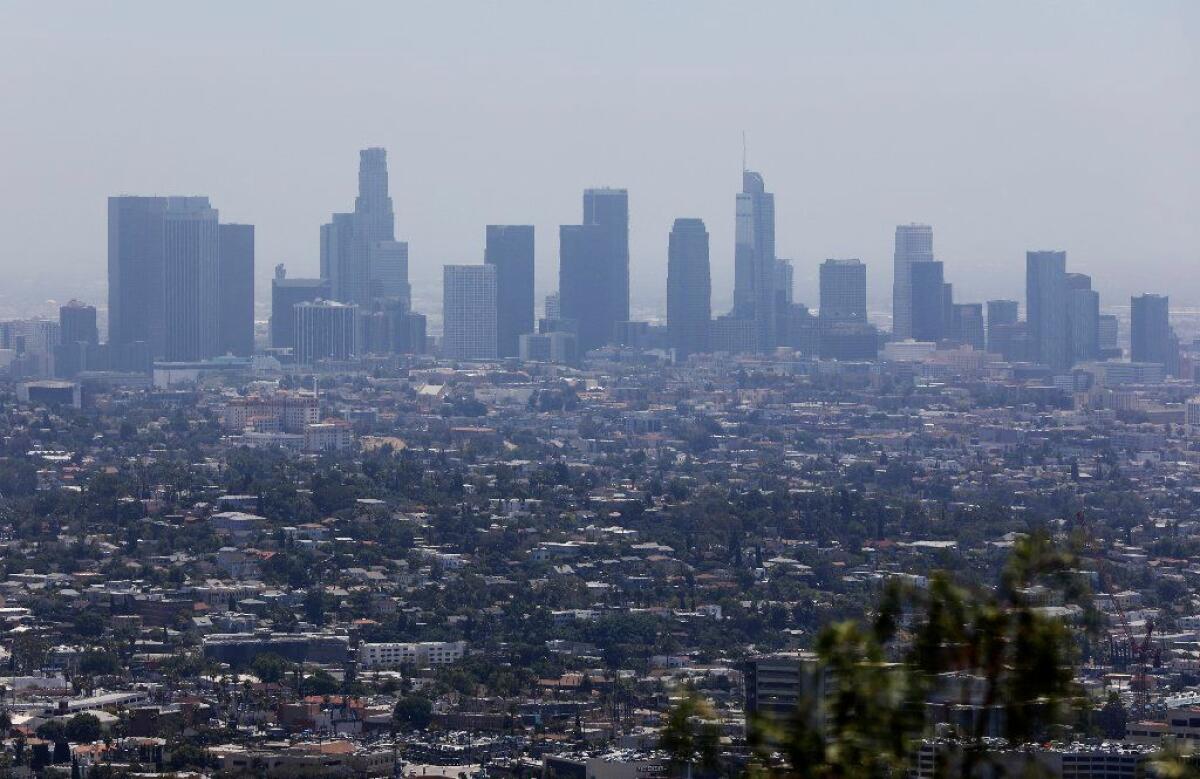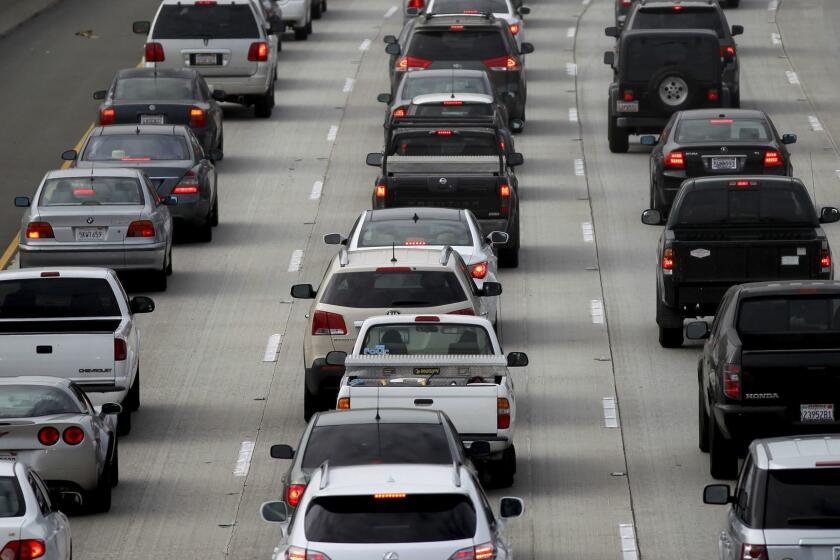New satellite measurements show how polluted Los Angeles’ air really is

- Share via
Scientists who scanned the skies above dozens of U.S. cities have made a surprising discovery about the smog that’s suspended over Los Angeles: one of its key ingredients isn’t disappearing as fast as it once did.
The finding may help explain why the once-steady improvements in air quality have come close to stalling out here even though nitrogen oxide emissions have continued to decline. It also suggests that the particular chemistry of L.A.’s air may complicate future cleanup efforts.
“That’s certainly part of why we’re in a moment in Los Angeles where it’s harder to get the air cleaner,” said Ronald Cohen, an atmospheric chemist at UC Berkeley who reported the findings in the journal Science.
Cohen and his former graduate student Joshua Laughner identified other cities where levels of nitrogen oxides — known collectively as NOx — have fallen out of tandem with emissions in recent years. But the discrepancy is particularly important for Los Angeles because the pollutant is so abundant here.
“The results of this study will be important in pointing the way toward future reductions in smog,” said John Seinfeld, an atmospheric chemist at Caltech who was not involved in the work.
Nitrogen oxides — a combination of nitric oxide (NO) and nitrogen dioxide (NO2) — are generated by motor vehicles and industrial machines like power plants, boilers, turbines and cement kilns.
When NOx molecules are mixed with volatile organic compounds — from vehicles and a vast array of household and commercial products — and exposed to sunlight, they help form pollutants like ozone.
When it comes to air quality, the products you use to smell nice or keep your kitchen clean could do just as much damage as the car you drive.
NOx emissions have fallen at a rate of roughly 7% a year from 2006 to 2013 across most U.S. cities, Cohen said. Scientists had presumed there was a direct correlation between those emissions and NOx levels in the air. Any variations in the length of time NOx lasted in the air probably wouldn’t have much effect on those levels, the thinking went.
“What we wanted to know is, is that assumption ... true?” Cohen said.
To find out, he and Laughner used satellite data to measure nitrogen dioxide — a good proxy for nitrogen oxides as a whole — in 28 U.S. cities, including Memphis, Indianapolis and New York. They focused on city centers, presumably the epicenter of the area’s NOx emissions, and measured how quickly those levels dropped with distance.
It turned out that the length of time the molecules stuck around in the atmosphere before being broken down by chemical reactions seemed to follow different patterns over time in different cities.
It “changed over the last decade, and it changed in really interesting ways,” Cohen said. “In some places the lifetime got longer, in some places it got shorter. In some places it did one and then the other.”
In cities like Los Angeles, Memphis and Washington D.C., those NOx lifetimes fell from 2006 until around 2010. Then they started to creep up again.
This could help explain why, after years of steady drops in the overall amount of NOx in Los Angeles’ air, that decline began to slow around 2010 and almost level out through 2013, the most recent year covered in the study.
The differences in NOx lifetimes in L.A. and elsewhere may be due in part to the particular chemical makeup of the atmospheres above each city, Cohen said.
“What we can’t do is explain why some cities behave in one way and why in another,” Cohen said. “We think it’s because we don’t understand the organic molecules in those cities.”
The emissions cuts in Los Angeles do seem to have made a big difference. Taking the NOx lifetime changes into account, the researchers estimated that there were more than 41 metric tons of NOx in the air above L.A. in 2006; by 2010, there were around 27 metric tons. That was the largest drop among all the cities over that time period.
However, since 2010, the decline slowed and nearly flattened, dropping only to 25 metric tons in 2013.
That left Los Angeles with NOx levels high above second-place Chicago (with nearly 17 metric tons) and third-place Detroit (just under 12 metric tons).
Los Angeles started out with so much more NOx for a few inescapable reasons, Cohen said. First off, there are a lot of people with a lot of cars. Second, the city lies in a basin, which makes it harder for airborne chemicals to escape.
“Los Angeles is always in the lead,” Seinfeld said. “This is where smog first appeared.”
But focusing on total amounts of NOx isn’t really a fair comparison, Laughner said, because the estimates are based on emissions from the county that contains a given city center. That means emissions from throughout the 4,751 square miles of Los Angeles County were attributed to L.A., while New York City was saddled only with emissions from the 22.8 square miles of Manhattan. (Each of the Big Apple’s five boroughs is a distinct county.)
When the scientists looked at the concentrations of NOx in each city’s air, New York reigned supreme in 2013, at 4.7 quadrillion molecules per square centimeter. Chicago was next, with 4.1 quadrillion; Los Angeles came in third, with 4 quadrillion.
Los Angeles also had the greatest improvement in its concentrations over the study period, dropping by 45%, compared to about 40% for New York and Washington, D.C., and about 36% for Chicago.
Laughner, who is now a postdoctoral scholar at Caltech, said the situation above Los Angeles may well have improved since 2013.
“Some surface measurements of NOx in Pasadena do show a decrease in the last few years,” he said.
The next step is to figure out what factors are driving these differences in NOx behavior. Cohen said a likely culprit is each city’s particular composition of volatile organic compounds.
As for where he’d prefer to live after conducting this study, Cohen said he still liked his home base in San Francisco’s East Bay just fine — though that decision had nothing to do with NOx levels.
“I wouldn’t choose a city based on these graphs,” he said. “The air pollution in Los Angeles is worse than other places, but there’s all kinds of other good reasons to live in Los Angeles.”
In the long run, a better understanding of atmospheric chemistry should help scientists come up with strategies to improve the city’s air quality.
“We should make it so that people can choose where they live based on other criteria than the quality of the air they breathe.”








